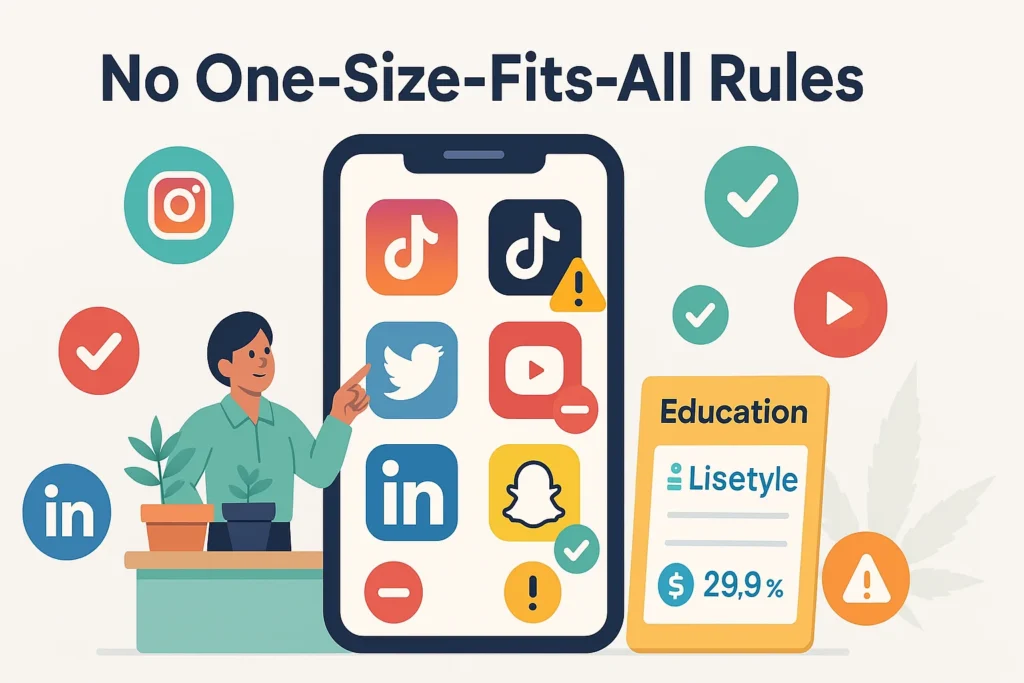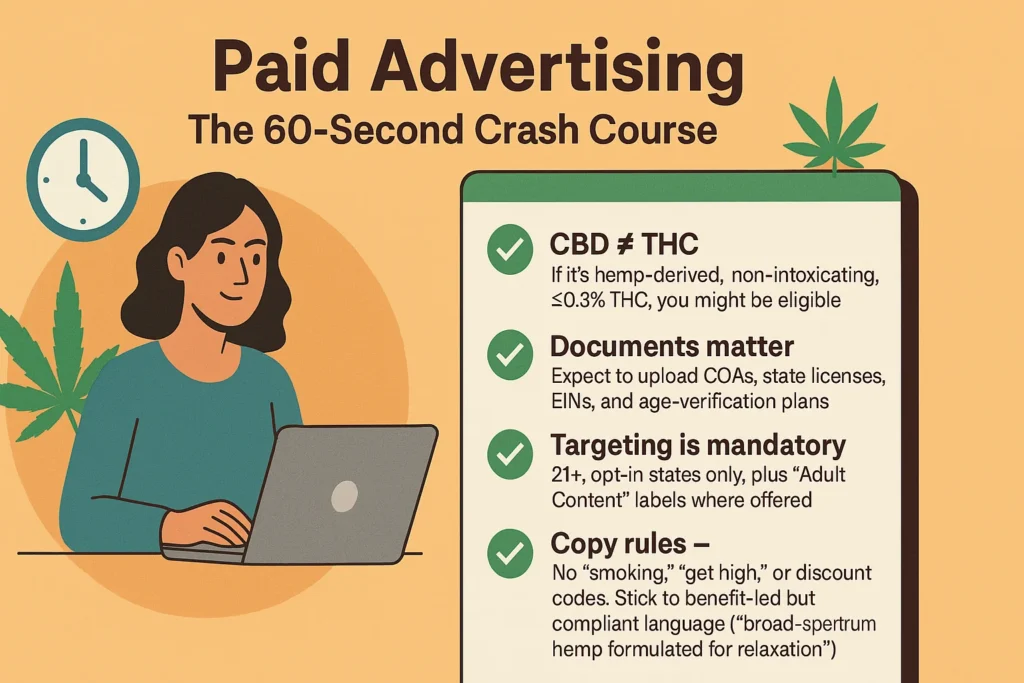Even though 40+ U.S. states now allow medical or adult-use cannabis, the plant is still federally illegal (the DEA’s long-discussed re-scheduling decision has not yet taken effect). That federal contradiction shapes every major platform’s rules
1. Why “one-size-fits-all” never works
| Platform | Core Rule of Thumb | Can You Advertise? | Biggest Instant-Ban Triggers |
|---|---|---|---|
| Instagram / Facebook (Meta) | Educational or “lifestyle” content is okay. No pricing, ordering, or claims to cure diseases. | Yes, but only for hemp-derived CBD with ≤0.3 % THC and you must prove legal status & target 18 + (21 + in the U.S). | “Shop now” links selling THC products, showing consumption, or celebratory “420 sale!” posts |
| X (formerly Twitter) | Relaxed in early-2024: licensed U.S. advertisers can promote THC, but must geotarget legal states and age-gate 21 +. | Yes (the first mainstream platform to allow THC ads) | Images of smoking, edibles that look like candy, medical claims |
| TikTok | Zero-tolerance on anything that “promotes, sells, or depicts” cannabis. Even the 💨 emoji can trip the filter. | No | Hashtags like #weed or showing buds; account deletions are common |
| YouTube | Educational content is allowed; monetization if you avoid usage demos & under-18 viewers. | No paid ads for THC. Limited CBD ads via Google’s “CBD pilot.” | Tutorials on how to get high, links to purchase |
| B2B hemp & ancillary services posts usually fine; avoid consumer-facing sales language. | No for THC; Yes for hemp/CBD with pre-approval. | “Buy now” CTA, photos of consumption | |
| Niche subs (r/trees, r/CBD) flourish, but commercial sellers get banned if they link to shops. | Pilot CBD ad program; THC ads prohibited. | Selling THC directly, giveaways | |
| Snapchat | Allows age-gated CBD ads (U.S. 18 +). Stories/photo posts follow Meta-style rules. | Yes for CBD with documentation. | THC product shots, price promotions |
| Disallows “illicit drugs” in paid ads but permits hemp & CBD educational pins. | No THC; limited CBD | Product sale pins, images of smoke |
Lorem ipsum dolor sit amet, consectetur adipiscing elit. Ut elit tellus, luctus nec ullamcorper mattis, pulvinar dapibus leo.
2. What is generally allowed (organic)
Education & news – “How terpenes affect aroma,” “New state regulations,” or “Behind the grow lights” tours.
Lifestyle imagery – Plants, packaging, store interiors, staff spotlights (no visible consumption).
Advocacy & social-justice content – Expungement efforts, patient stories (with no medical claims).
Memes & culture – Keep them PG-13 and avoid direct product pushes.

3. What’s almost never allowed
| 🚫 Don’t Do This | Why It Fails |
|---|---|
| Show someone lighting, inhaling, or eating THC | Violates “depicts consumption” rules |
| Post prices, discounts, or “Add to Cart” links | Seen as direct sales of a federally illegal substance |
| Target minors or use child-appealing graphics | Automatic suspension |
| Make health-cure claims (“CBD cures anxiety”) | Considered unsubstantiated medical claims |
| Use paid influencer placements without disclosure | FTC + platform penalties |
4. Paid advertising: the 60-second crash course
Paid advertising can be very useful if it’s allowed when selling your product.
- CBD ≠ THC – If it’s hemp-derived, non-intoxicating, ≤0.3 % THC, you might be eligible.
Documents matter – Expect to upload COAs, state licenses, EINs, and age-verification plans.
Targeting is mandatory – 21 +, opt-in states only, plus “Adult Content” labels where offered.
Copy rules – No “smoking,” “get high,” or discount codes. Stick to benefit-led but compliant language (“broad-spectrum hemp formulated for relaxation”).
Review times can be weeks – Build campaigns early and anticipate rejections.

5. Surviving the compliance maze
Create a “platform-safe” content calendar – Mark each post as “educational,” “culture,” or “sales-free.”
Keep ecommerce on your own site – Link to a landing page that age-gates visitors before any product pricing appears.
Use link-in-bio tools carefully – Services like Linktree are fine if the destination pages themselves follow the rules.
Diversify channels – Don’t rely on Instagram alone; email lists and SMS (with TCPA compliance) remain the safest revenue drivers.
Monitor shadow-bans – Sudden drops in reach? Pause paid boosts, audit hashtags, and remove borderline posts.
Stay updated monthly – Platform cannabis rules change more often than their logos.
6. Content ideas that stay on the right side of the line
“Strain of the Week”—focus on aroma descriptors and terpene science, not effects.
Sustainable cultivation tips—position your brand as eco-friendly without overt selling.
Team spotlights—humanize the company, build trust.
Regulation explainers—short Reels summarizing new state rules (rank well on Google, too).
Recipe reels using hemp seed or CBD isolate—avoid THC & emphasize wellness.
7. Final takeaways for 2025
Social media isn’t impossible for cannabis brands—it’s just unforgiving. Treat every post like a compliance checklist, keep the true “buy” moment on your own age-verified website, and nurture audiences with education, culture, and transparent storytelling. Platforms will keep tweaking policies, but brands that respect the rules, document everything, and diversify channels will stay visible—and stay live.
Need help navigating these rules?
➡️ Reach out to the GreenBoost team—we live and breathe cannabis-friendly growth strategies.
Check out our post on Cannabis marketing, SEO, and Compliance options: https://greenboost.online/a-comprehensive-guide-to-effective-cannabis-marketing-seo-and-compliance-options/


Pingback: SEO & Cannabis Marketing in 2025: A Definitive Guide